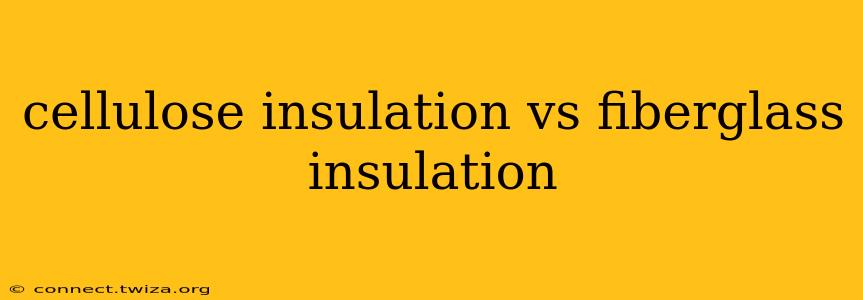Choosing the right insulation for your home is a crucial decision impacting energy efficiency, comfort, and long-term costs. Two popular options frequently top the list: cellulose and fiberglass. This comprehensive guide dives deep into the differences between cellulose insulation and fiberglass insulation, helping you make an informed choice for your specific needs.
What is Cellulose Insulation?
Cellulose insulation is a sustainable and effective material made from recycled paper products. Treated with borates for fire resistance and pest deterrence, cellulose is blown into wall cavities and attics, conforming to the space's unique shape for optimal thermal performance. Its loose-fill nature allows it to easily settle around pipes and wires, minimizing gaps and air leaks.
What is Fiberglass Insulation?
Fiberglass insulation, a widely used material, is manufactured from glass fibers bound together. It's available in various forms, including batts (rolls), blankets, and loose-fill. Fiberglass insulation offers good thermal performance and is relatively inexpensive, making it a popular choice for many homeowners. However, it's less environmentally friendly than cellulose and requires more careful handling due to potential skin irritation from the glass fibers.
Cellulose Insulation vs. Fiberglass Insulation: A Detailed Comparison
Here's a head-to-head comparison of key characteristics:
R-Value:
- Cellulose: Offers a high R-value per inch, meaning excellent thermal resistance. The exact R-value can vary depending on the density and moisture content.
- Fiberglass: Also provides good thermal resistance, with R-values varying based on thickness and density. Generally, fiberglass insulation needs to be thicker to achieve the same R-value as cellulose.
Cost:
- Cellulose: Often slightly more expensive upfront than fiberglass, but the superior insulating properties can lead to significant long-term energy savings.
- Fiberglass: Generally less expensive initially, but may require more material to achieve the same level of insulation, potentially negating the initial cost savings.
Environmental Impact:
- Cellulose: A highly sustainable option, made from recycled materials and reducing landfill waste. It's also biodegradable and requires less energy to produce compared to fiberglass.
- Fiberglass: The manufacturing process of fiberglass consumes significant energy and resources, and the material itself isn't biodegradable.
Installation:
- Cellulose: Requires specialized equipment for blowing into wall cavities and attics. Professional installation is usually recommended to ensure proper density and coverage.
- Fiberglass: Batts and blankets are relatively easy to install for DIY projects, while loose-fill fiberglass requires specialized equipment, similar to cellulose.
Moisture Resistance:
- Cellulose: While treated to resist pests and fire, cellulose can be susceptible to moisture damage if not properly installed and protected.
- Fiberglass: Generally performs well in dry conditions but can absorb moisture over time, leading to reduced R-value and potential mold growth.
Health and Safety:
- Cellulose: Generally considered safe, with the borate treatment providing protection against pests and fire. However, proper respiratory protection is recommended during installation.
- Fiberglass: Can cause skin irritation and respiratory problems if fibers are inhaled during handling and installation. Always wear appropriate protective gear.
What are the advantages of cellulose insulation?
Cellulose insulation boasts several advantages, including:
- High R-value: Excellent thermal performance for superior energy efficiency.
- Sustainability: Made from recycled materials, reducing environmental impact.
- Air sealing: Its loose-fill nature helps seal gaps and air leaks, further improving energy efficiency.
- Fire resistance: Treated with borates to inhibit fire spread.
- Pest resistance: Borate treatment also deters pests from infesting the insulation.
What are the disadvantages of cellulose insulation?
While advantageous in many aspects, cellulose insulation also presents some drawbacks:
- Higher initial cost: Can be slightly more expensive than fiberglass initially.
- Specialized installation: Requires professional installation for optimal performance.
- Moisture sensitivity: Susceptible to moisture damage if not properly protected.
What are the advantages of fiberglass insulation?
Fiberglass insulation offers several attractive features:
- Lower initial cost: Generally less expensive than cellulose.
- Ease of installation (batts & rolls): DIY installation is feasible for batts and rolls.
- Widely available: Easily accessible from most home improvement stores.
What are the disadvantages of fiberglass insulation?
However, fiberglass insulation comes with some disadvantages:
- Lower R-value per inch: Requires more thickness to achieve the same thermal resistance as cellulose.
- Environmental impact: Not as environmentally friendly as cellulose.
- Potential health hazards: Can cause skin and respiratory irritation if handled improperly.
- Less effective air sealing: Can leave gaps and air leaks unless carefully installed.
Which insulation is best for me?
The best insulation for your home depends on several factors, including your budget, environmental concerns, and the specific needs of your project. Consider consulting with a qualified insulation contractor to determine the most suitable option for your home's unique characteristics and climate. They can assess your home's energy needs and recommend the most effective and cost-efficient insulation solution. Weighing the pros and cons outlined above will help you make a well-informed decision that improves your home's comfort and energy efficiency for years to come.
